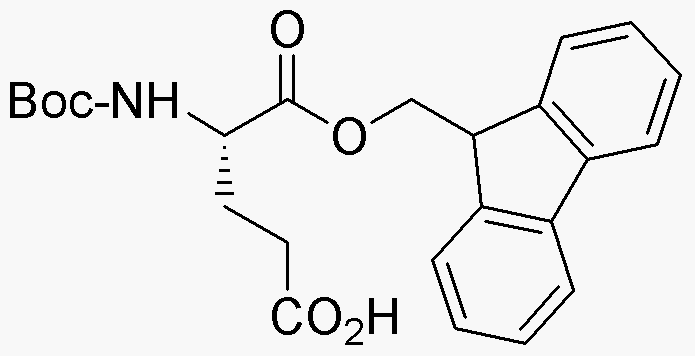Boc-L-glutamic acid a-9-fluorenylmethyl ester is widely utilized in research focused on:
- Peptide Synthesis: This compound serves as a protecting group in the synthesis of peptides, allowing for selective reactions without interfering with other functional groups. This is crucial in developing complex peptides for pharmaceuticals.
- Drug Development: Its application in medicinal chemistry helps in designing and optimizing drug candidates, particularly those targeting neurological disorders, by modifying amino acid sequences for improved efficacy.
- Bioconjugation: The compound is used in bioconjugation processes, linking biomolecules such as proteins and antibodies to therapeutic agents, enhancing their delivery and effectiveness in targeted therapies.
- Research in Protein Engineering: It aids in the modification of proteins, allowing researchers to study structure-function relationships, which is essential for developing new biocatalysts or therapeutic proteins.
- Analytical Chemistry: The compound is utilized in various analytical techniques, such as HPLC, to separate and identify amino acids and peptides, providing valuable insights into biochemical processes.
General Information
Properties
Safety and Regulations
Applications
Boc-L-glutamic acid a-9-fluorenylmethyl ester is widely utilized in research focused on:
- Peptide Synthesis: This compound serves as a protecting group in the synthesis of peptides, allowing for selective reactions without interfering with other functional groups. This is crucial in developing complex peptides for pharmaceuticals.
- Drug Development: Its application in medicinal chemistry helps in designing and optimizing drug candidates, particularly those targeting neurological disorders, by modifying amino acid sequences for improved efficacy.
- Bioconjugation: The compound is used in bioconjugation processes, linking biomolecules such as proteins and antibodies to therapeutic agents, enhancing their delivery and effectiveness in targeted therapies.
- Research in Protein Engineering: It aids in the modification of proteins, allowing researchers to study structure-function relationships, which is essential for developing new biocatalysts or therapeutic proteins.
- Analytical Chemistry: The compound is utilized in various analytical techniques, such as HPLC, to separate and identify amino acids and peptides, providing valuable insights into biochemical processes.
Documents
Safety Data Sheets (SDS)
The SDS provides comprehensive safety information on handling, storage, and disposal of the product.
Product Specification (PS)
The PS provides a comprehensive breakdown of the product’s properties, including chemical composition, physical state, purity, and storage requirements. It also details acceptable quality ranges and the product's intended applications.
Certificates of Analysis (COA)
Search for Certificates of Analysis (COA) by entering the products Lot Number. Lot and Batch Numbers can be found on a product’s label following the words ‘Lot’ or ‘Batch’.
*Catalog Number
*Lot Number
Certificates Of Origin (COO)
This COO confirms the country where the product was manufactured, and also details the materials and components used in it and whether it is derived from natural, synthetic, or other specific sources. This certificate may be required for customs, trade, and regulatory compliance.
*Catalog Number
*Lot Number
Safety Data Sheets (SDS)
The SDS provides comprehensive safety information on handling, storage, and disposal of the product.
DownloadProduct Specification (PS)
The PS provides a comprehensive breakdown of the product’s properties, including chemical composition, physical state, purity, and storage requirements. It also details acceptable quality ranges and the product's intended applications.
DownloadCertificates of Analysis (COA)
Search for Certificates of Analysis (COA) by entering the products Lot Number. Lot and Batch Numbers can be found on a product’s label following the words ‘Lot’ or ‘Batch’.
*Catalog Number
*Lot Number
Certificates Of Origin (COO)
This COO confirms the country where the product was manufactured, and also details the materials and components used in it and whether it is derived from natural, synthetic, or other specific sources. This certificate may be required for customs, trade, and regulatory compliance.


